Pink personalities for the new year
Welcome to January flamingo followers. In this update I'll fill you in on some happenings in the flamingo flocks and what's been happening over winter. You may be aware that it's avian 'flu season again in the UK and so the flamingos have been kept cosy and safe inside of their houses until we wait for this to pass. However, this does allow you to see into the world of the flamingo very closely, as the birds are not bothered by people watching them through the windows of their houses. Go slow, and keep the noise down (no banging on windows please) and the birds will reward you with some interesting to watch activities.
These close views are great for nose-to-beak flamingo watching; it's nice to see how the birds interact with one another and, perhaps more interestingly for those of you that are used to seeing flamingos from a distance, it's great great to see just what a flamingo looks like up close. For five of the six species I am always struck by how big they are when you see one at close range (even Mr James is pretty chunky). Lesser flamingos always look mini, but what they are lesser for in size, they are maximum in for colour. And now's a great time to see these colours as they develop and change from winter into spring.
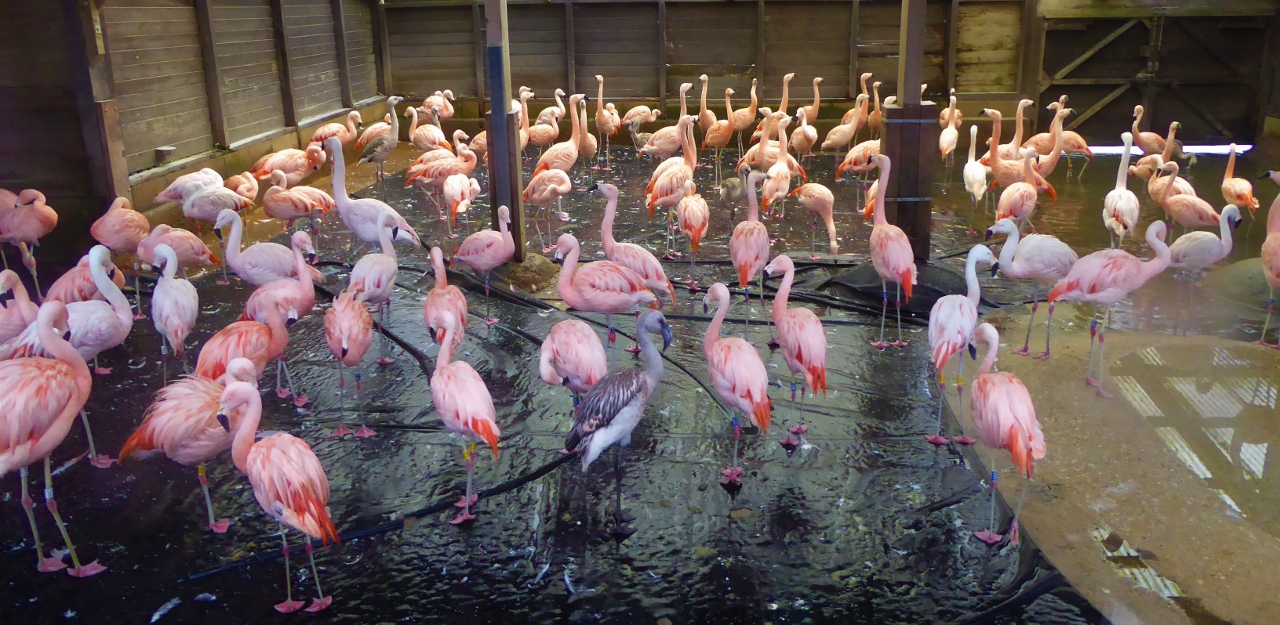 A mixture of colour, of parents, youngsters and birds getting ready to breed.
A mixture of colour, of parents, youngsters and birds getting ready to breed.
It's a mix of colour in all of the flamingo flocks at present. Phil and Sparky gets privileged access into the greater flamingo house (the one flamingo house that visitors cannot see into) as they have to tend to the birds everyday, two to three times a day. Phil sent over this short clip of the greater flamingos displaying- it looks like he's immersed in the middle of them, and part of the flock! This clearly is a happy group of birds.
If you wander down to the South American Pen and say hello to the Chilean flamingos you'll get to see how the chicks from summer 2017 are growing up. And you might also spot a new pink feather appearing... You can see some pink spots sprouting on the chick in the photo below. Chileans are relatively slow growers, and these chicks still look a little fluffy around the edges. But it won't be too long before they start to more closely resemble the adults. There are six youngsters to look out for in the flock.
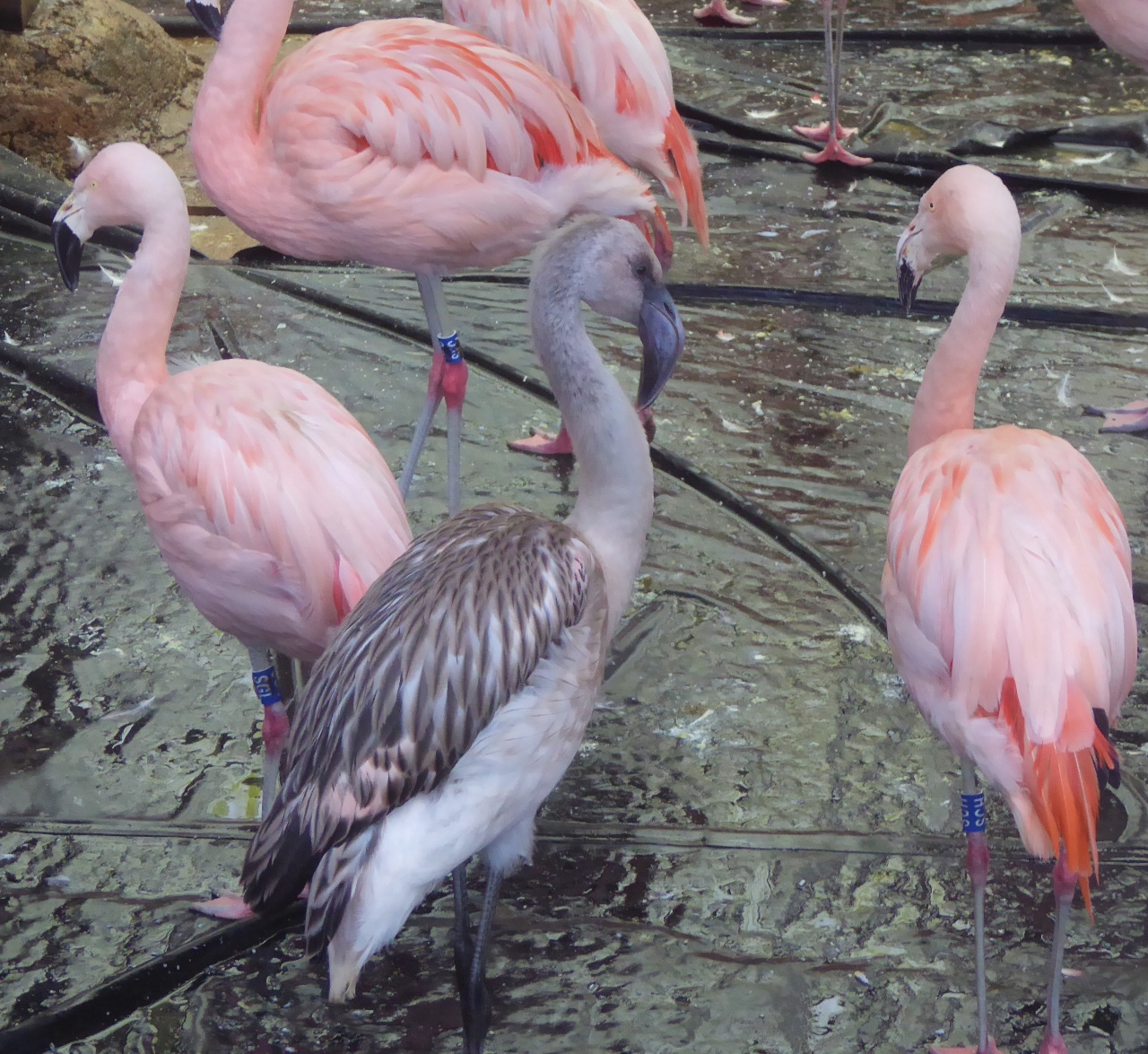 Spot the first pink feathers... Chileans grow up more slowly than greaters and Caribbeans. But the first signs of pink are sprouting.
Spot the first pink feathers... Chileans grow up more slowly than greaters and Caribbeans. But the first signs of pink are sprouting.
The other thing that you will be able to observe closely at the moment is the differences in colour between past parent flamingos, and birds getting ready for breeding. I know that I talk about it a lot but it's something that fascinates me- how the birds move in and out of their bright pink plumage across the course of a year. You can see how vivid this difference in plumage types is in the photo below. Several parent Chilean flamingos are bright white, and really stand out against the pink backdrop of their flock-mates.
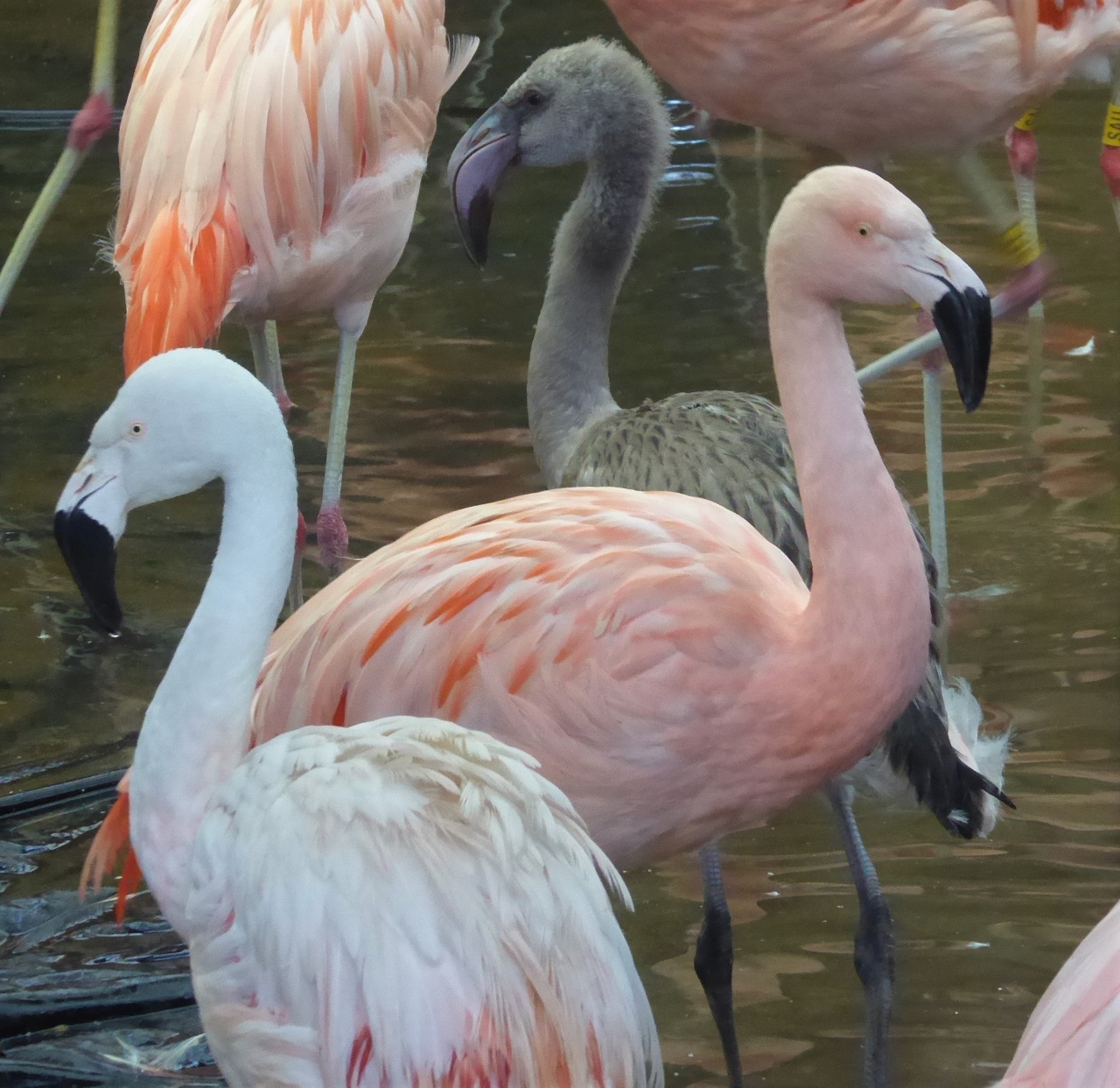 A parent (white), adult ready for breeding (pink) and a grey youngster showing that flamingos turn from grey to white feathers and add the pinkness themselves.
A parent (white), adult ready for breeding (pink) and a grey youngster showing that flamingos turn from grey to white feathers and add the pinkness themselves.
I really like this photo because it captures the stages of a flamingo's life. And how important colour is to them. The plain grey-brown is slowly replaced by white feathers, but because the youngster has been fed on carotenoids (in its crop milk) by its parents, and then will start eating flamingo pellet on its own when weaned that these first adult feathers come through pink. You can see that the base colour of an adult flamingo is actually white, because the parent- after feeding its chick on crop milk full of carotenoids- has no pink pigment left to "stain" its new plumage with.
The photo below is a favourite of mine. I took it the other day after watching the Chilean chicks begging for milk from their parents (who were keen to make them go and fend for themselves!). The pink birds in the shot are all different shades, more obvious on some than others, and the chick in the background has a few of the oh-so-classic-Chilean-flamingo salmon pink flashes appearing. Some of the birds in this photo are grand old ladies and gentlemen- especially the large male flamingo second from the front with his distinguished bill profile; it's great to see the different generations all together and know that this new bird will benefit from the age, wisdom and experience (and know just "how to be a flamingo") from its compatriots.
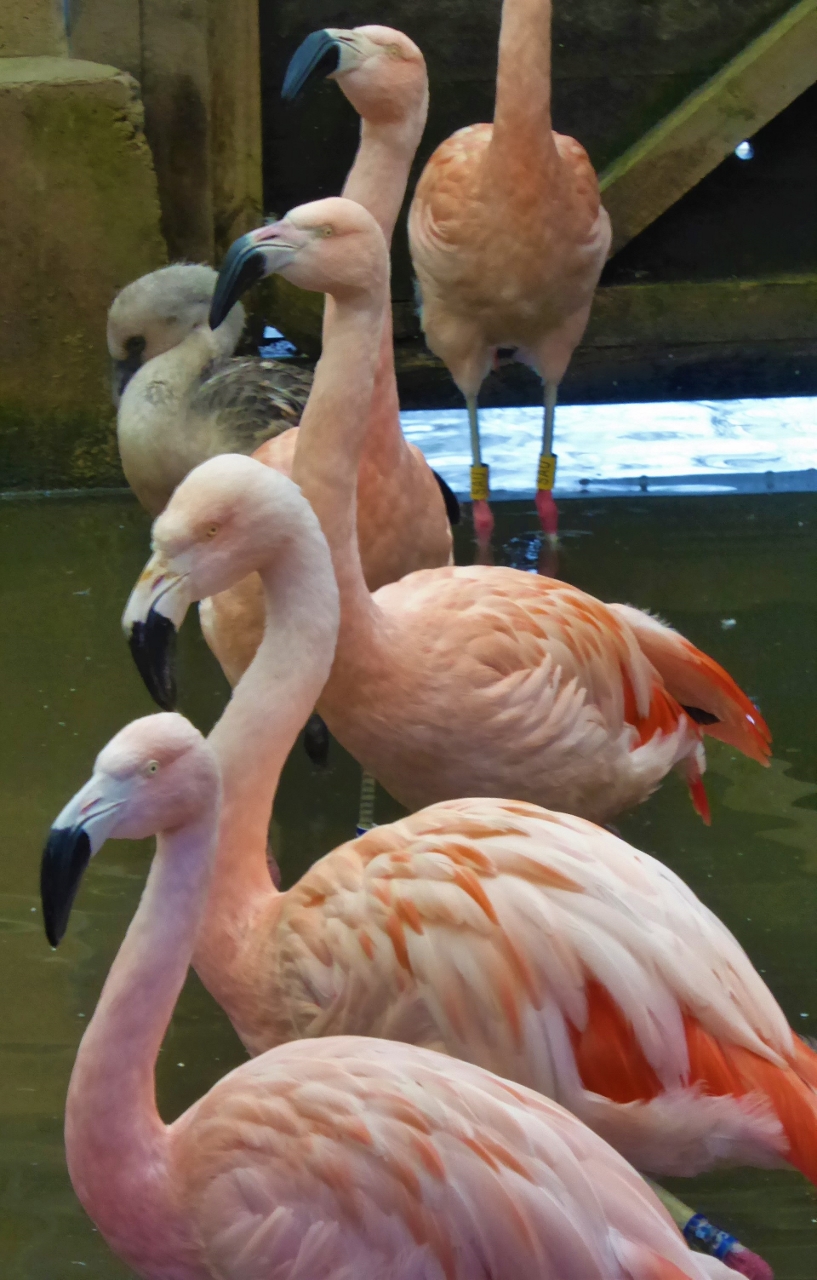 I love this photo. A line of adults and a youngster at the back, and look at the different shades of pink. Colour tells you a lot about how a flamingo is currently doing and what it might do in the future.
I love this photo. A line of adults and a youngster at the back, and look at the different shades of pink. Colour tells you a lot about how a flamingo is currently doing and what it might do in the future.
All of this new pinkness is important for the upcoming breeding season. Lessers, Chileans, Andeans, and Caribbeans have all been putting on some great courtship dancing of late. The greaters too are in the mood, but alas you'll have to wait until they are back on view. I was lucky enough to see the Chileans displaying the other day- and they were in sync with each other. In fact, it looked like they were practising a routine! There's a short video of this below. Watch how the ripples of wing flashes and wing salutes, finished off with some twist preens spreads across the flocks, turns into head flagging and then the cycle continues.
I mentioned about colour in the lesser flamingos too. These birds are looking amazing at the moment, and there are some very, very deep red shades appearing on their feathers. Again, the close views that you can get whilst they are inside their house shows how the feather colour develops and where on the bird's body. You can kind of see this in the photo below, deeper, more intense pigment on the birds' faces. Gradually this will spread out and become more uniform.
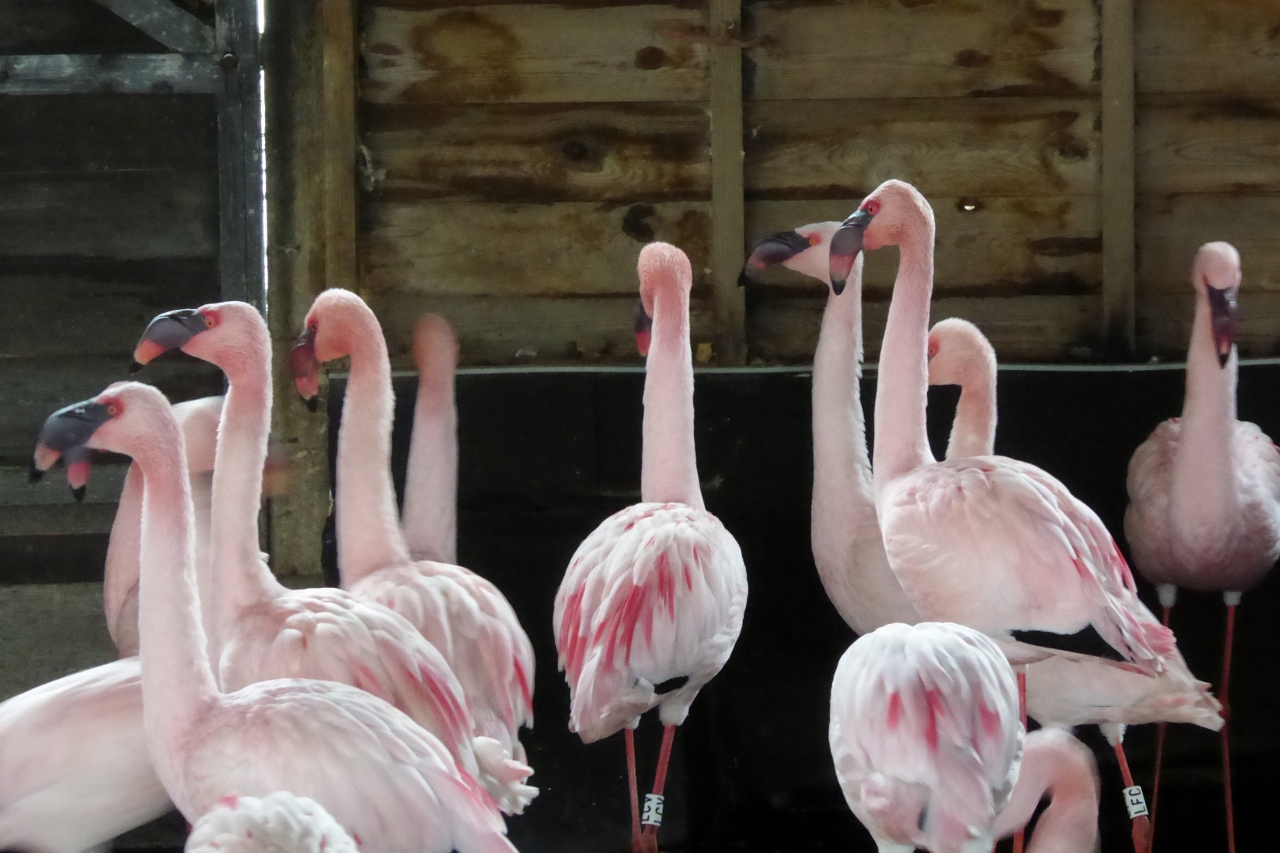 Stains on the heads of the lesser flamingos show that deeper red breeding plumage is starting to develop.
Stains on the heads of the lesser flamingos show that deeper red breeding plumage is starting to develop.
The other cool thing to notice about the lesser flamingos is what they are saying to each other. If you watch the clip below with your volume turned up you will hear a range of different vocalisations that the flamingos are making to one another. And in this context it is related to breeding behaviour.
https://www.youtube.com/watch?v=ifmYI2oSakY
You can see a group of flamingos stalking around with their heads held high. These birds want to start marching (that group movement that lesser flamingos are so famous for performing) and so they are making specific types of noise to get other birds in the mood too. It is this upright pose, and the birds moving closer and closer together that gives the game away. The low, long grunting calls are characteristic of lesser flamingos that are clearly keen to get everyone dancing. In the clip below you can see how the birds are trying to egg each other on (bad pun).
The photo below, of a large section of the flock, shows the differences in posture and colour more easily. Birds are preening lots- keeping their feathers in tip-top condition ready to impress in their group dancing events. And some very pale birds have yet to start moulting into new pink plumage for the spring. Lesser flamingos are tricky to look after well, and can be very sensitive. This photo, and the lovely colours and condition of the bird, really shows how well they are kept by Sparky and Phil and co. It's no easy job to get lessers looking this pretty in the middle of winter.
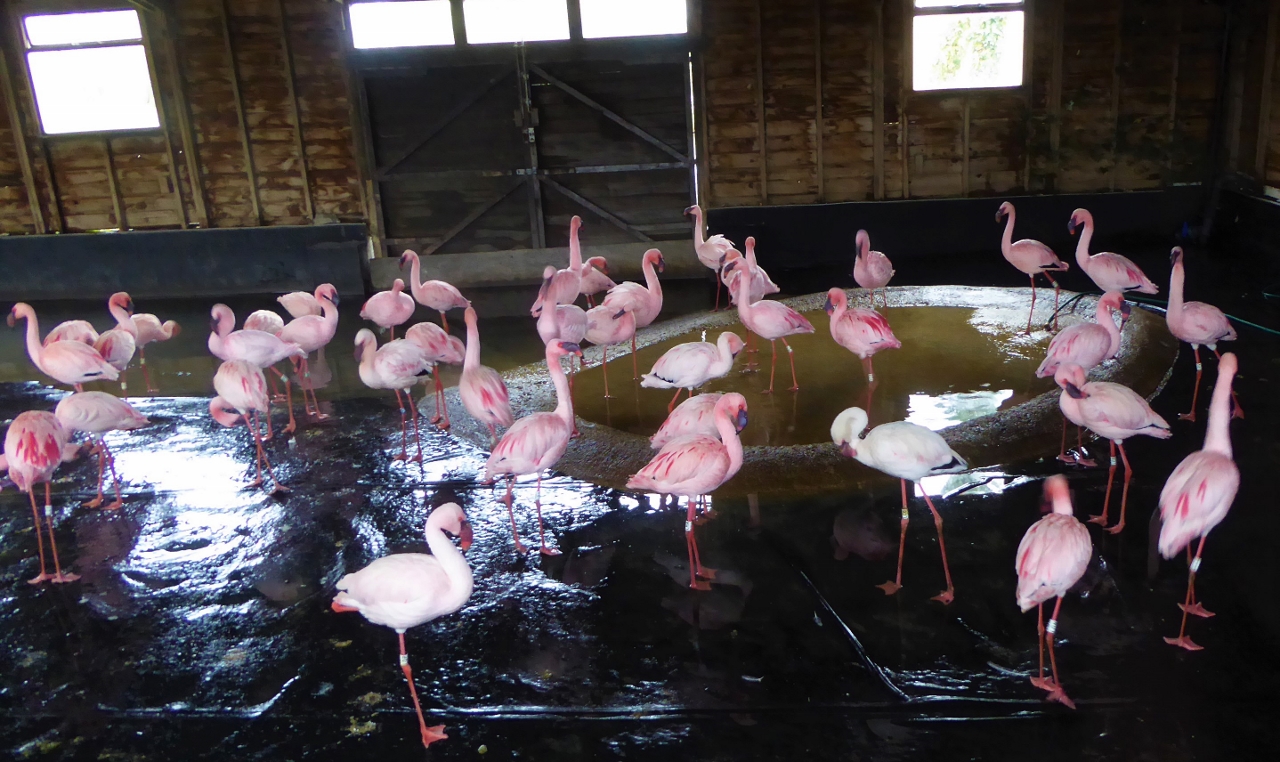 A riot of colour. Pale through to bright red.
A riot of colour. Pale through to bright red.
On your next visit to WWT Slimbridge be sure to visit each of the flamingo flocks and see them inside their houses. Whilst they are not currently out and about, there is still a lot to see and the birds' behaviours are as fascinating as ever. The colours of spring are really starting to appear on all birds, even in Mr James, who again has his bright orange legs and beautiful crimson breeding plumes. He also has a wonderfully bright pink head, which is much more vivid than his neck. I was trying hard to get a photo of this, but all he would give me is that shown in the photo below... sometimes even the most famous of flamingos can be camera shy.
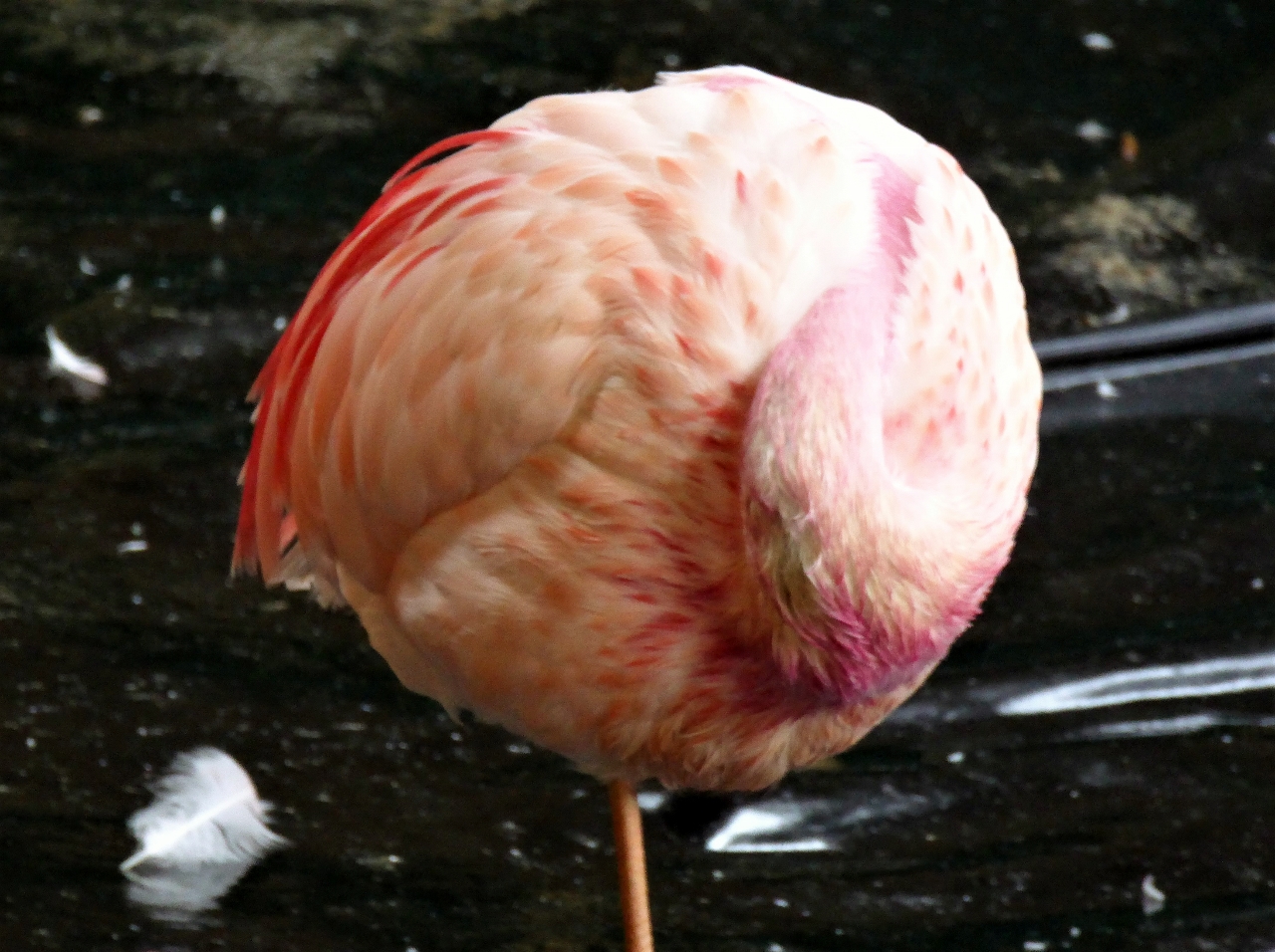 This is not a lollipop. This is Mr James doing his best impression of one.
This is not a lollipop. This is Mr James doing his best impression of one.



